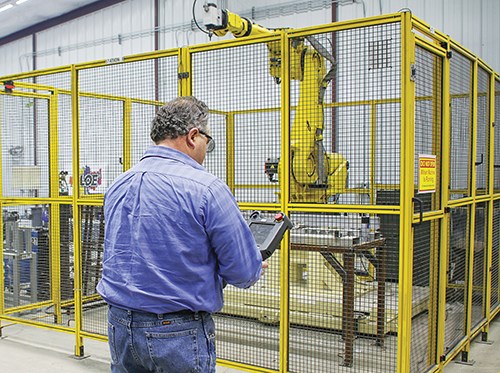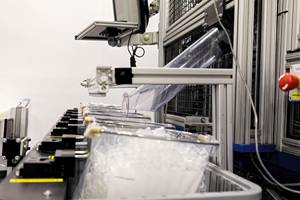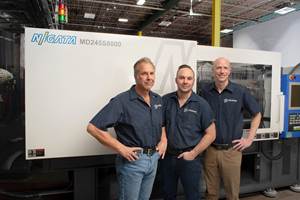Recreational-Products Firm ‘FLOEs’ into Forming
FLOE International got started making products for boaters. It still does. But now it also thermoforms extremely large parts, both for captive products and to support other thermoformers who need big-part capabilities.
From boat lifts, docks, aluminum trailers, and other recreational-industry products to ... custom thermoforming? While this may not be the path customarily taken by new entrants in plastics processing, it’s how FLOE International, a family-owned, 32-year-old company, got into the business a year ago.
Based in McGregor, Minn., FLOE supported this foray into forming with a $5 million investment that included the construction of a 42,000 ft² production plant, with plans on the horizon to expand by another 40,000 ft². This was no impulsive decision, notes Mark Krezowski, v.p. sales and marketing. FLOE started investigating launching a thermoforming business about 10 years ago, noting that many of the parts it was designing for its recreational products were farmed out to other formers. The plant layout was drawn up more than two years ago when FLOE decided that it would focus on highly automated, very large-part forming as a way to distinguish itself from those already established in this business and carve out a much-needed niche.
To that end, FLOE purchased what’s believed to be the world’s largest three-station rotary vacuum former. The machine was built by AVT, Gladwin, Mich., and sold originally to a Texas company that planned on using it to form boat hulls and large parts for the recreational-vehicle industry. FLOE bought it in May 2012 and spent a significant amount of money upgrading its controls and other capabilities, says Krezowski.
The enormous machine is 75 ft in diameter and stands 40 ft tall. It features automated sheet load/part unload, a huge oven, and giant mold stations. It can form heavy-gauge sheet (up to 0.6 in. thick) in sizes up to more than 10 x 25 ft with draws up to 6 ft. The ceramic oven system consists of 2280 programmable elements within 1140 control zones, allowing for precise heating.
The upper and lower mold-station platens support mold weights up to 13,736 lb per platen. A 7000-gal dedicated vacuum storage system ensures control over part forming. The machine is also equipped with 14 dedicated mold-temperature-control units (16 kW each) so that molds will be evenly heated and cooled to maximize molding efficiency and provide the lowest cycle times possible. A 60-ton chiller provides rapid mold cooling, as do platen-cooling fans placed throughout the mold station.
The machine took eight tractor trailers to ship to FLOE. The first order of business in designing the new plant was to dig an 11-ft-deep pit to house the machine’s plumbing and other connections.
The new plant, which started making parts only about a year ago, is equipped with two other formers. Another three-station rotary built by MAAC Machinery Corp. Carol Stream, Ill. is for large parts using sheet sizes up to 8 x 4 ft. This machine is small only when compared to the AVT former: It’s 25 ft in diameter and 12 ft tall. The MAAC rotary forms heavy-gauge (up to 0.5-in.) sheet with draws up to 2 ft. The ceramic oven system consists of 180 programmable elements within 90 zones of control. It also has a dedicated vacuum storage system and dedicated mold-temperature-control units.
The third machine is an AAA shuttle for large parts with up to a 2-ft draw running sheet sizes up to 7 x 4 ft. This is a twin-shuttle pressure and vacuum former, 15 ft in diameter by 12 ft tall, that forms sheet to 0.5-in. thick. Its ceramic oven system consists of 240 programmable elements within 120 zones. It is also equipped with its own vacuum-storage system and fluid mold-temperature-control units.
FLOE is an advocate of lean manufacturing, and its new thermoforming operation is no different. Post-forming operations include everything from the placement of decals to the addition of custom components. FLOE has also purchased several robots for value-added operations such as trimming, deburring, and drilling.
CNC technology has also been among FLOE’s core competencies for years,remarks Krezowski. Three- and five-axis CNC machines integrated with CAD software from SolidWorks, Waltham, Mass. (solidworks.com) are used to support FLOE’s moldmaking and repair operations. Integrated CAD and CNC systems allow for rapid prototyping of parts as well as building mold patterns and prototype molds. Production aluminum molds are designed with cavity surfaces, plumbing for heating and cooling, and an internal vacuum system.
AMBITIOUS GROWTH PLANS
Why would a company with a four-decade track record of building recreational products get into thermoforming? There are two reasons. States Wayne Floe, the company’s founder and still its sole owner, “We were already designing parts for thermoforming, so why not make them? We wanted to build a business that was more vertically integrated while at the same time strong enough and different enough to support an outside venture. We also thought that with a machine this size we could design and manufacture products that never before were thermoformed.”
To that end, Floe notes that the company “has a lot of ideas on the drawing board that will utilize our technology to bring all kinds of new thermoformed products to the market.”
One is about to be commercialized. FLOE’s home state of Minnesota is nicknamed “the Land of 10,000 Lakes.” And where there are lakes there are fish. And where there are fish there are fishermen. In response, FLOE is introducing a thermoformed hut or “house” for ice fishermen that will consist of two 6 x 6 ft pieces that snap together. Big enough for two people, the hut will have a carpeted floor with four holes in it and will be heated. It will be formed out of HMW-HDPE 0.4-in. thick with an insulated floor framed out of extruded aluminum.
Floe says, “We know a lot about aluminum because of our recreational parts business. We work with many aluminum extruders who produce hundreds of our custom shapes that are used in our proprietary products.
Floe adds, “This in-depth experience really has been very complimentary for engineering new products that combine the unique benefits of thermoformed products with our custom aluminum shapes.
“This has the potential to be a huge business for us,” Floe continues. “Normally fishermen build these kind of houses themselves, mostly out of wood.” The two-piece house nests, which makes them easy to disassemble and makes shipping easier. “We can fit 110 of these houses on one semi-truck.”
The move into thermoforming also balances FLOE’s recreational products business, which is seasonal. “It made sense for us to build a business that added another, more steady revenue stream,” says Floe.
The thermoformer is also making a new product called a hay hut. It ‘s 6 ft tall and sits over a large round bale of hay and features eight windows through which hungry horses can feed. Technically, the product isn’t new—it used to be rotomolded. “In this application it took too long to rotomold parts, and the consistency varied greatly,” remarks Krezowski. “Finally when the mold had gotten beaten up, we were able to provide a new solution.”
On the custom side of its business, a big part of FLOE’s strategy—and Krezowski’s job—is to partner with other formers that lack FLOE’s capacity to produce big parts. “A lot of large OEMs like to deal with lean enterprises,” Wayne Floe says. “We’ve been on a lean journey for many years,” he adds. “We have about 120 employees company-wide but we have no quality-control department. That’s because everyone is involved in quality control. That makes us very appealing to these companies. It also makes it easier for us to pick up projects from our thermoformer partners.”
Krezowski says these partnerships are fairly informal though they might require non-disclosure agreements. Ideas and technology are shared among the formers.
“We feel we are filling a need in the marketplace with technology that can make parts as large as we can,” states Krezowski. “In some cases we are even creating the need.”
As a private company, FLOE would not divulge its overall sales or its sales of its new thermoforming enterprise. However, the company is confident that thermoforming will quickly become a major portion of its business. Wayne Floe adds, “There are quite a few companies out there that need very large thermoformed parts. That’s where we fit in. We think there is a lot of volume and opportunity out there for us to capture and even create.”
FLOE will be exhibiting this month at the NPE2015 show in Orlando, March 23-27.
Related Content
As Currier Grows in Medical Consumables, Blow Molding Is Its ‘Foot in the Door’
Currier Plastics has added substantial capacity recently in both injection and blow molding for medical/pharmaceutical products, including several machines to occupy a new, large clean room.
Read MoreNovel ‘Clamtainer’ Extends Thermoformer's Reach in Packaging
Uniquely secure latching expands applications for Jamestown Plastics’ patented clamshell package design.
Read MoreCustom Injection Molder Plugs into All Electric Machines
Formerly a showroom for early-aughts-era Van Dorn hydraulics, the newest additions to Drummond Industries’ transforming fleet are all-electric Niigata injection molding machines.
Read MoreLFT-D Thrives in Automotive and Other Durables
Teijin Automotive acquires its 10th direct long-fiber thermoplastic system as demand for this technology soars.
Read MoreRead Next
Processor Turns to AI to Help Keep Machines Humming
At captive processor McConkey, a new generation of artificial intelligence models, highlighted by ChatGPT, is helping it wade through the shortage of skilled labor and keep its production lines churning out good parts.
Read MoreAdvanced Recycling: Beyond Pyrolysis
Consumer-product brand owners increasingly see advanced chemical recycling as a necessary complement to mechanical recycling if they are to meet ambitious goals for a circular economy in the next decade. Dozens of technology providers are developing new technologies to overcome the limitations of existing pyrolysis methods and to commercialize various alternative approaches to chemical recycling of plastics.
Read MoreHow Polymer Melts in Single-Screw Extruders
Understanding how polymer melts in a single-screw extruder could help you optimize your screw design to eliminate defect-causing solid polymer fragments.
Read More


















.png;maxWidth=300;quality=90)















